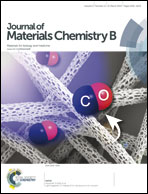Discrimination between bacterial phenotypes using glyco-nanoparticles and the impact of polymer coating on detection readouts†
Abstract
The identification and treatment of bacterial infections remains a major healthcare challenge, especially to ensure appropriate application of a limited spectrum of antibiotics. Here we describe a system capable of discriminating between different strains of Escherichia coli using multivalent, carbohydrate-functionalised, gold nanoparticles based on their different expression levels of the FimH adhesin. Upon binding of the glycosylated nanoparticles to FimH positive bacteria, the nanoparticles' optical properties change enabling the identification of bacteria strain. Comparison between direct conjugation, or via a linker, of the carbohydrate to the nanoparticle revealed significant effects on the performance of the detection system. Using a poly(ethylene glycol) spacer increased the stability, and specificity, of the glycosylated nanoparticles but also reduced aggregation upon bacterial binding. This prevented the well-known red-blue gold colour change, meaning spectrophometric, rather than optical, assessment methods were required. Using this method, FimH positive bacteria could be detected at approximately 1.5 × 107 colony forming units per mL.


 Please wait while we load your content...
Please wait while we load your content...